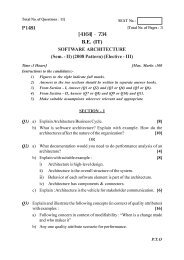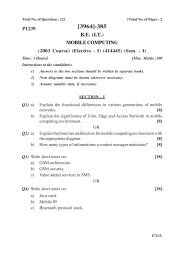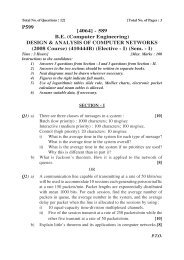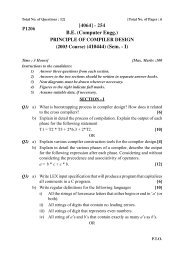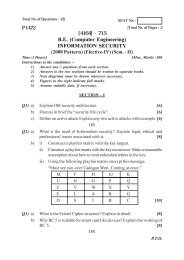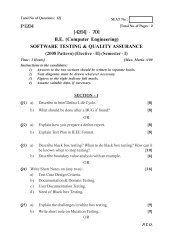Cloud Computing and SOA Convergence in Your Enterprise: A Step ...
Cloud Computing and SOA Convergence in Your Enterprise: A Step ...
Cloud Computing and SOA Convergence in Your Enterprise: A Step ...
You also want an ePaper? Increase the reach of your titles
YUMPU automatically turns print PDFs into web optimized ePapers that Google loves.
Def<strong>in</strong><strong>in</strong>g the Information Model 95<br />
Underst<strong>and</strong> Integrity Issues<br />
When analyz<strong>in</strong>g databases for cloud comput<strong>in</strong>g, <strong>in</strong>tegrity issues constantly<br />
crop up. In order to address these, it is important to underst<strong>and</strong> the rules <strong>and</strong><br />
logic that were applied to the construction of the database. For example, will<br />
the application allow the update of customer <strong>in</strong>formation <strong>in</strong> a customer table<br />
without first updat<strong>in</strong>g demographics <strong>in</strong>formation <strong>in</strong> the demographics table<br />
Most middleware, such as the middleware that connects on-premise systems<br />
to clouds, take <strong>in</strong>to account the structure or rules built <strong>in</strong>to the databases<br />
be<strong>in</strong>g connected. As a result, there exists the very real threat of damage<br />
to the <strong>in</strong>tegrity of target databases when relationships are not properly understood<br />
<strong>and</strong>/or def<strong>in</strong>ed.<br />
While some databases, <strong>in</strong>clud<strong>in</strong>g on-premise <strong>and</strong> cloud-based systems,<br />
do come with built-<strong>in</strong> <strong>in</strong>tegrity controls (such as stored procedures or triggers),<br />
most rely on the application logic to h<strong>and</strong>le <strong>in</strong>tegrity issues on behalf<br />
of the database. Unfortunately, the faith implicit <strong>in</strong> this reliance is not always<br />
well placed. All too often, it is pa<strong>in</strong>fully naïve when you consider that your<br />
cloud comput<strong>in</strong>g system will be widely distributed, which makes it difficult<br />
to create a common control mechanism to protect database <strong>in</strong>tegrity.<br />
The lack of <strong>in</strong>tegrity controls at the data level (or, <strong>in</strong> the case of exist<strong>in</strong>g<br />
<strong>in</strong>tegrity controls, bypass<strong>in</strong>g the application logic to access the database directly)<br />
could result <strong>in</strong> profound problems. Architects <strong>and</strong> developers must<br />
approach this danger cautiously, mak<strong>in</strong>g sure they do not compromise databases’<br />
<strong>in</strong>tegrity <strong>in</strong> their zeal to move to cloud comput<strong>in</strong>g.<br />
Underst<strong>and</strong> Data Latency<br />
Data latency, the characteristic of the data that def<strong>in</strong>es how current the <strong>in</strong>formation<br />
needs to be, is another property of the data that must be determ<strong>in</strong>ed<br />
for the purposes of leverag<strong>in</strong>g cloud comput<strong>in</strong>g. Such <strong>in</strong>formation allows the<br />
architects to determ<strong>in</strong>e when the <strong>in</strong>formation should be copied or moved to<br />
another enterprise system, such as on-premise to the clouds, <strong>and</strong> how fast.<br />
While an argument can be made to support a number of different categories<br />
of data latency, for our purpose of def<strong>in</strong><strong>in</strong>g architecture for cloud comput<strong>in</strong>g,<br />
there are really only three:<br />
1. Real-time<br />
2. Near-time<br />
3. Some-time



